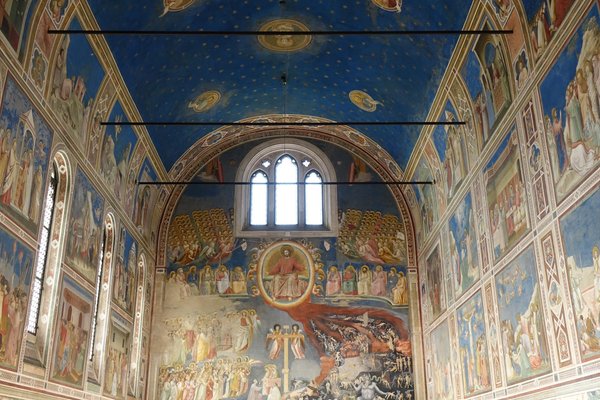Italy
Padua’s fourteenth-century fresco cycles
Padua’s fourteenth-century fresco cycles comprise significant 14th-century mural paintings.
They reflect the pre-humanist climate of Padua, where the clergy, the city and the aristocracy all commissioned works. The paintings in particular show scientific and astrological allegories. Although they are spread across eight buildings and were made by different artists, they show unity in an innovative style that Giotto started.
Community Perspective: The Scrovegni Chapel is definitely the highlight here. Your pre-booked timeslot will allow you 15 minutes to take it all in (that’s usually sufficient). Hubert also visited the 7 other components and compared them.
Site Info
Official Information
- Full Name
- Padua’s fourteenth-century fresco cycles (ID: 1623)
- Country
- Italy
- Status
-
Inscribed 2021
Site history
History of Padua’s fourteenth-century fresco cycles
- 2021: Name change
- Upon inscription from "‘Padova Urbs picta’, Giotto’s Scrovegni Chapel and Padua’s fourteenth-century fresco cycles" to "Padua’s fourteenth-century fresco cycles"
- 2021: Inscribed
- Inscribed
- 2016: Revision
- Includes former TWHS Cappella degli Scrovegni (2006)
- Type
- Cultural
- Criteria
- ii
Links
- UNESCO
- whc.unesco.org
- Official
-
- padovaurbspicta.org — Padova Urbs Picta nomination website
- cappelladegliscrovegni.it — Cappella degle Scrovegni
All Links
UNESCO.org
- whc.unesco.org — whc.unesco.org/
Official Website
- padovaurbspicta.org — Padova Urbs Picta nomination website
- cappelladegliscrovegni.it — Cappella degle Scrovegni
Community Information
- Community Category
- Religious structure: Christian
Travel Information
Reservation required
Veneto hotspot
Recent Connections
-
Civic Measures
Under the arches of the Palazzo della R…
-
Foucault Pendulums
The pendulum was placed in the Palazzo …
-
Odoric of Pordenone
The frescoes were made after his death,…
Connections of Padua’s fourteenth-century fresco cycles
- Individual People
-
-
Charlemagne
In the St. James Chapel of the Basilica of St. Anthony of Padua, the frescoes show "Charlemagne's Council, which contains actual portraits of some of the most significant figures associated with the Carraresi court (...) and a portrait of Charlemagne himself; this latter shows a clear resemblance to emperor Louis of Hungary, an ally of the Carraresi rulers of Padua. The entire image is, therefore, a clear political statement of the prestige of both the lords of Padua and of the Lupi family." (Nomination file, p. 121) -
Giotto
The fresco cycles "include Giotto's Scrovegni Chapel fresco cycle, considered to have marked the beginning of a revolutionary development in the history of mural painting". (Official description)See en.wikipedia.org
-
Donatello
The equestrian monument of Gattamelata in front of the Basilica of Saint Athony is by Donatello. Donatello also created the high altar in the Basilica and "the gilded bronze statues that decorate it". (Nomination file, p. 114-115) -
Odoric of Pordenone
The frescoes were made after his death, but he returned to the Friary of the Basilica of St. Anthony after his travels.
-
- Trivia
-
-
Built elsewhere as a full size replica
"A 1:1 scale replica of the Scrovegni Chapel is located in Japan, at the Otsuka art museum"See it.wikipedia.org
-
- History
-
-
Knights Templar
Various Templar signs can be spotted in the Scrovegni Chapel, such as the red crosses of the three side altars found in the nave, the largest of which are dedicated to Saint John and Saint Catherine of Alexandria, to whom the knights were very devoted; the crosses on Christ's halos; the frequent depictions of the fleur-de-lys that characterize many Templar buildings and that Giotto reproduces on top of the angels' sceptres, but also as a decorative element of robes, furnishings and many buildings.See it.wikipedia.org
-
Places of Execution
The Piazza delle Erbe was the scene of capital executions since the Middle Ages, with Piazza Castello. It was also called Justice Square and the statue of Justice with the sword and scales, placed above the Torre degli Anziani, looked right over the place where the stage for the executions was mounted, under the windows of the Palazzo del Podesta. The loggias of the Palazzo della Ragione were also places of capital punishment, where another statue of Justice looked.See it.wikipedia.org
-
Popes
Three popes came from the canonical chapter of the Cathedral of Padua: Eugene IV, Paul II and Alexander VIII.See it.wikipedia.org
-
Sieges and Battles
Siege of Padua (1509): During the war of the League of Cambrai (1509), Padua was at the centre of the fighting and the basilica was located a short distance from the fortifications and therefore, finding itself between two fires, it suffered the fury of the besieged Venetian troops on one side and the reprisals of the besieging imperial army, which occupied it on and off.See it.wikipedia.org
-
- Ecology
-
-
Notable Trees
The Cloister of the Chapter of the Basilica of Saint Anthony of Padua is also called the Magnolia Cloister because in the centre of the garden, there is a rare and majestic specimen of magnolia grandiflora, one of the 88 monumental trees officially registered in Veneto as of 2017.See it.wikipedia.org
-
- Architecture
-
-
Renaissance
Basilica of St. Anthony of Padua: "the high altar itself is one of the most important features of the Basilica, not to say one of the greatest expressions of the Italian Renaissance." (Nomination file, p. 114) -
Designed by Michele Sanmicheli
The architectural project of the Mausoleum of Alessandro Contarini in the Basilica of Saint Anthony of Padua was coordinated by Michele Sanmicheli, assisted by numerous sculptors.See it.wikipedia.org
-
Brick architecture
Scrovegni Chapel: "The exterior of the chapel is in bare brickwork and is crowned with a coping formed of small projecting arches." "The exterior of the Church of the Eremitani is bare brick with pilaster strips and cornices resting on small projecting arches." The Oratory of St. George "has a very simple bare-brick exterior". (Nomination file, p. 50, 66, 132) -
Carrara marble
The presbytery under the big dome in Padua's Duomo is completely in Carrara marble.See it.wikipedia.org
-
Palladio and Palladian style
The monument dedicated to Pietro Bembo in the Basilica of Saint Anthony of Padua is a project by the architect Andrea Palladio.See it.wikipedia.org
-
Baroque
Basilica of St. Anthony of Padua: "The largest of the chapels that open off the ambulatory is the Treasury Chapel, a baroque work by the Genoese architect Filippo Parodi, a pupil of Bernini." (Nomination file, p. 115) -
Gothic
"the Basilica of St. Anthony of Padua (...) is characterised by a fusion of different styles: Romanesque, in features of its gabled façade; Gothic, in the floor plan of the ambulatory with its nine chapels; Byzantine, in the eight lead-sheeted cupolas and in the two slim bell-towers." (Nomination file, p. 112) – "in the decoration of the Oratory of St. George this model [of frescoes] is explored in a way that reflects the new style of International Gothic." (Nomination file, p. 136) -
Romanesque
"the Basilica of St. Anthony of Padua (...) is characterised by a fusion of different styles: Romanesque, in features of its gabled façade; Gothic, in the floor plan of the ambulatory with its nine chapels; Byzantine, in the eight lead-sheeted cupolas and in the two slim bell-towers." (Nomination file, p. 112) -
Restored by anastylosis
The Church of the Eremitani "was severely damaged during a bombing raid on 11 March 1944 (...) Reconstruction work began at the east end of the church - that is, with the Great Chapel, the Dotto Chapel and the Ovetari Chapel and its antechapel. All of the shaped stone and wall fragments recovered - many of them decorated with fresco fragments - were painstakingly re-assembled; and what was still missing after this anastylosis was supplied by newly-worked pieces that were given a different finish and also dated." (Nomination file, p. 237-238) -
Domes
Cathedral of Padua and the Basilica of Saint Anthony of PaduaSee en.wikipedia.org
-
- Damaged
-
-
Damaged in World War II
most of Mantegna'a frescoes at the Ovetari Chapel (Eremitani) -
Destroyed by Hurricanes or Typhoons
Palazzo della Ragione: "A tornado destroyed the roof and damaged the building on 17 August 1756."See en.wikipedia.org
-
Damaged in World War I
During the bombings of the First World War a bomb hit the façade of the Cathedral which ruined the upper part.See it.wikipedia.org
-
Destroyed or damaged by Earthquake
On 29 May 2012 the Basilica of St. Anthony of Padua was damaged by one of the earthquakes that hit the Emilia-Romagna area; there were detachments on over 3 m² of plaster decorated by Casanova. The fragments were collected and placed safe, under the control of the Superintendency. The entire ambulatory that runs around the presbytery has been protected, so that any other detachments cannot hit pilgrims.See it.wikipedia.org
-
- World Heritage Process
-
-
2 or more nominated criteria rejected by AB
Rejected: 1,3. Accepted: 2 -
Perfect Inscriptions
2021 -
Extended from original TWHS
Originally Scrovegni Chapel only -
Inscribed on a single criterion only
ii
-
- Religion and Belief
-
-
The Magi
One of the frescoes in the Scrovegni Chapel depicts the adoration of the Magi. (Nomination file, p. 52) -
Augustinian Order
Eremitani -
Christian Pilgrimage Sites
"The Pontifical Basilica of Saint Anthony of Padua (...) is visited as a place of pilgrimage by people from all over the world".See en.wikipedia.org
-
Cathedrals
Padua Cathedral, or Basilica Cathedral of Saint Mary of the Assumption (the frescoes are in the Baptistery) -
Marian Shrines
Padua's Duomo is dedicated to the Assumption of Mary. One of the chapels in the cathedral is dedicated to Our Lady of Miracles and displays a miraculous icon of the Virgin with the baby Jesus.See it.wikipedia.org
-
Franciscan Order
The Basilica of St. Anthony of Padua is governed by the Franciscans of the Order of Friars Minor Conventual.See it.wikipedia.org
-
Religious Relics
St. Anthony's chin and tongue at the Basilica of St. Anthony
-
- Human Activity
-
-
Frescoes or murals by famous painters
Giotto’s fresco cycle in the Scrovegni Chapel -
Inscribed significantly for a Work of Fine Art by a single artist
Giotto
-
- Constructions
-
-
Sphinx
two Egyptian sphinxes in Palazzo della Ragione -
Monumental Columns
Colonna del Peronio on the Piazza della FruttaSee it.wikipedia.org
-
Cenotaph
The equestrian statue of Gattamelata was originally conceived as a cenotaph.See it.wikipedia.org
-
Bazaars and Market Halls
"The Palazzo della Ragione is a medieval market hall, town hall and palace of justice building in Padua (...) the ground floor still hosts the historical covered market of the city."See en.wikipedia.org
-
Mausolea
The Cathedral Baptistery was "ultimately used as a mausoleum" for the city's Prince Francesco il Vecchio da Carrara and his wife Fina Buzzaccarini who commissioned its decoration. The Oratory of St. George "was intended as a family mausoleum and was commissioned by Raimondino Lupi da Soragna to house the mortal remains of the very same Bonifacio Lupi di Soragna who just a few years previously had commissioned Altichiero da Zevio to decorate the St. James Chapel within the Basilica." (Nomination file, p. 100, 132, 169) -
Obelisk
A small obelisk tops the Colonna del Peronio on the Piazza della Frutta.See it.wikipedia.org
-
Astronomical clocks
On the Torre dell'Orologio on the Piazza dei Signori. The astronomical clock is the oldest surviving machine of its kind in the world and with a diameter of 5.6 m, it is also one of the largest. It was the first to be created in Italy and the second in the world.See it.wikipedia.org
-
Prison
"In 1797 the" Oratory of St. George "served as a military prison, a use which led to substantial damage to the lower level of frescoes, particularly those near the entrance." (Nomination file, p. 247) -
Equestrian Statues
Gattamelata at the Basilica of St. AnthonySee de.wikipedia.org
-
Sundial
In the cloister of the novitiate of the Basilica of St. Anthony of Padua there is a sundial bearing the inscription "Your hour is always uncertain".See it.wikipedia.org
-
Triumphal Arches
The triumphal arch below the Torre dell'Orologio on the Piazza dei SignoriSee it.wikipedia.org
-
Unfinished constructions
The façade of the Cathedral of Padua is unfinished.See it.wikipedia.org
-
Cemeteries
The cloister of Paradise (Chiostro del Paradiso) surrounds a part of the ancient churchyard around the apse of the Basilica of Saint Anthony of Padua. The cloister is so called because in the past the garden was used as a cemetery.See it.wikipedia.org
-
Clock Tower
Torre dell'Orologio on the Piazza dei SignoriSee it.wikipedia.org
-
Tombs
St. Anthony's tomb at the Basilica of St. Anthony -
Historic Military Parade Grounds
The Piazza Capitaniato was the ancient parade ground of the Reggia Carrarese, the palace of the Carraresi family.See it.wikipedia.org
-
Roman amphitheatres
"The Scrovegni Chapel stands on a site where one can still see remains of the Roman amphitheatre (known as l'Arena). In fact, various elements of that ancient structure are used by the building: the gabled façade rests on the outline of the amphitheatre's external elliptical wall, and the side walls of the chapel seem to be traced along the radial walls that were part of it." (Nomination file, p. 50) -
Loggia
Palazzo della Ragione: "The long sides have a double order of loggias which link the interior with the outside space". + "the Carraresi Palace (...) has an elegant double loggia, dating from the fourteenth century". (Nomination file, p. 80, 92)
-
- WHS on Other Lists
-
-
Part of Our Top 50 Missing
listed as 23 in top 50 missing
-
- Timeline
-
-
Built in the 14th century
painted between 1302 and 1397 by different artists
-
- WHS Hotspots
-
-
Veneto hotspot
Padua is 30min by train from Venice
-
- Science and Technology
-
-
Civic Measures
Under the arches of the Palazzo della Ragione, in the "Canton delle Busie" (Corner of Lies), official standard measures for cloth, bricks, and tiles are carved into the white stone. These were used to resolve disputes in the market that has operated in the surrounding square for 800 years (link)
-
Astronomy and Astrology
astrological depictions of the months in Palazzo della Ragione -
Foucault Pendulums
The pendulum was placed in the Palazzo della Ragione ("Palace of Reason") on April 19, 2006, by the University of Padua and the local municipality to serve as a permanent scientific bridge within the medieval building. Suspended from a 20-meter steel wire attached to the historic wooden roof beams, the 13 kg sphere oscillates in the southeast corner of the great hall, specifically positioned beneath the fresco of Aries. This placement is deeply intentional, as it marks the starting point of the building's massive 14th-century zodiacal cycle, which depicts human character and labor as determined by the movement of the stars.
The pendulum was introduced during the International Year of Physics to manifest the city’s identity as a center of scientific inquiry and to honor its historical connection to figures like Pietro d'Abano. (link)
-
Universities
Two departments of the University of Padua (Philosophy, Sociology, Pedagogy and Applied Psychology & the School of Human, Social Sciences and Cultural Heritage) are housed in buildings around the Piazza Capitaniato.See it.wikipedia.org
-
- Visiting conditions
-
-
Reservation required
For Scrovegni Chapel: online, a few days ahead -
Visitor Limits
"In the case of the Scrovegni Chapel, tourist flow is controlled by a pre-booking requirement, for groups of limited size and visits of a specific length of time (admission by booking only/groups of up to 25 people/set lengths for each visit). (Nomination file, p. 253)
-
- WHS Names
-
-
Name changes
Upon inscription from "‘Padova Urbs picta’, Giotto’s Scrovegni Chapel and Padua’s fourteenth-century fresco cycles" to "Padua’s fourteenth-century fresco cycles"
-
News
No news.
Recent Visitors
Visitors of Padua’s fourteenth-century fresco cycles
- 4lex
- AC
- Adrian Turtschi
- Aitia
- Alberto Rodriguez Gutierrez
- alex
- Alexander Barabanov
- Alexander Lehmann
- Aljaz
- Alvaro1404
- Ammon Watkins
- Ana Lozano
- AndreaTLV
- Antonio J.
- Argo
- ArnaudFilloux
- Artur Anuszewski
- Aspasia
- Assif
- Astraftis
- a.thum
- Atila Ege
- awestix
- Badwater
- BaziFettehenne
- Bernard Joseph Esposo Guerrero
- Bill Maurmann
- Bin
- Carlos Sotelo
- Caspar
- Cezar Grozavu
- cflw
- chenboada
- chenqtao
- Cheryl
- CherylKla
- Chole Ross
- ChrisN
- christof
- Christoph
- Cluckily
- Clyde
- Crinion
- Csaba Nováczky
- CugelVance
- Cyberczar
- Dagmara
- Damientournay
- Daniela Hohmann
- Daniel Chazad
- Dan Pettigrew
- dave wood
- David Berlanda
- del
- Dennis Nicklaus
- Dimitar Krastev
- Dimitrios Polychronopoulos
- Dolemite92
- Don Irwin
- DonQuijote
- Dorejd
- Doubanjiang
- Dr. Caligari
- Dwight Zehuan Xiao
- edstar500
- Elia Vettorato
- Elliot
- Els Slots
- erdsaumnaht
- Erik G
- Errol Neo
- Eva Kisgyorgy
- Fan Yibo
- Farinelli
- Federico P.
- Fmaiolo@yahoo.com
- Frédéric M
- Frederik Dawson
- FS
- GabLabCebu
- Galgalula
- Gary Arndt
- Geert Luiken
- George Gdanski
- GeorgeIng61
- GerhardM
- giulio25
- Gjert
- Hadrianus
- Hammeel
- Harald T.
- Harry Mitsidis
- Hasco
- H Beswick
- henrik_hannfors
- Hubert
- Hurrvinek
- Ian Cade
- Ilya Burlak
- inomusay
- Ivan Rucek
- Jaakkotoivanen
- Jackson
- jacob76
- Jakob F.
- James Bowyer
- Jana and Matt
- Janina Lehmann
- Jan-Willem
- Jan Zimmermann
- Jarek Pokrzywnicki
- Jasam
- Javier Coro
- Jay T
- Jeanne OGrady
- Jeffrey Chai
- Jens
- Jezza
- Jgriffindor6
- JL
- João Aender
- JobStopar
- John Smaranda
- Jonas Kremer
- Joyce van Soest
- Justin
- KarenBMoore
- Karito Vies
- KateY
- Kbecq
- Ken DJ
- kjluebke
- Klara Woodson
- Klaus Freisinger
- KngAlaric
- Knut
- Krijn
- Krzysztof B
- Kurt Lauer
- kutasp
- La Concy
- Lara Adler
- lindaann
- Lisu Marian
- ljowers
- Loic Pedras
- Luboang
- Lucio
- Ludvan
- Luis Filipe Gaspar
- Lukasz Palczewski
- lynnz317@aol.com
- Maciej Gil
- Mahuhe
- Malgorzata Kopczynska
- Małgosia Łupicka
- MarcoB_0
- Marlies van Wolfswinkel
- Martin
- Martinacurra88
- Martina Rúčková
- Marton Kemeny
- maryhattie
- MAURO PODDA PANI
- MaYumin
- MH
- Michael Ayers
- MichaelH
- Michael Novins
- michaelsballard
- Mihai Dascalu
- Mo-han Je
- Mohboh
- Monica Tasciotti
- MoPython
- MystRivenExile
- Naim Y
- nan
- napalm
- Nasebaer
- Nick M
- opperpco3
- PabloNorte
- palka25
- Patrik
- Paul Schofield
- Peter Lööv
- Petteri
- Philipp Leu
- Philipp Peterer
- phillipmeng
- Pincze
- Piotr Wasil
- Porcho
- Priyaranjan Mohapatra
- puessergio
- Purrfect
- Rafał Kałczuga
- Ralf Regele
- Ralf Rotheimer
- Randi Thomsen
- Remigiusz
- Reza
- Riccardo Quaranta
- Rick Ohm
- rivr
- Roccobot
- Roger Ourset
- Roman Bruehwiler
- Ronbon
- Rudegirl
- Sabrina Liebehentschel
- Samato
- Samy G
- Sandmann15
- SDMArado
- Sehnsuchtsbummler
- SirLoydd
- Solivagant
- Squiffy
- Stan
- Stanislaw Warwas
- Stefan A. Michelfeit
- stephanvermeulen
- Stijn
- Sutul
- Svein Elias
- Szabolcs Mosonyi
- Szabo Viktoria
- Szucs Tamas
- takanenohana
- Tamara Ratz
- Taotao Chen
- Tarquinio_Superbo
- thisispivi
- Thomas Buechler
- Thomas van der Walt
- Tim Allen
- Tinamu
- tingmelvin
- tommasorossotti
- Tommy W
- Tonisan
- tony0001
- triath
- Tsunami
- Valentina
- valentinaui
- Vanessa Buechler
- VB73
- Veronica
- Viaje al Patrimonio
- WalGra
- Walter
- WILLIAM RICH
- Wimmy
- Wojciech Fedoruk
- Xander Huang
- Xiong Wei
- Xiquinho Silva
- YaroMir
- Yevhen Ivanovych
- Yongcheng Liu
- Zoë Sheng
- Zos M
Community Reviews
Show full reviewsElia Vettorato
Padua’s fourteenth-century fresco cycles
Padua’s fourteenth-century fresco cycles (Inscribed)
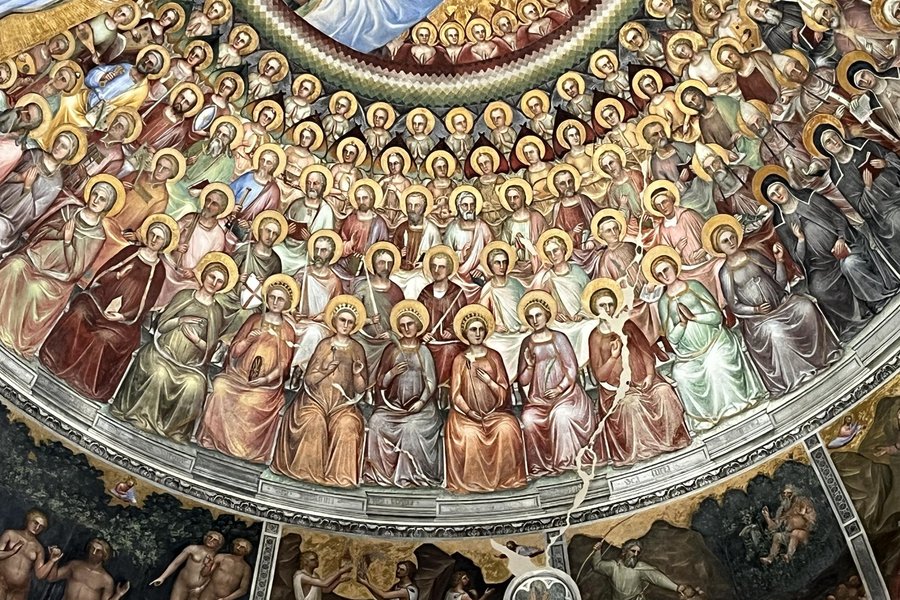
Padova is my city, so my judgement is surely cloud by pride and attachment. However, I think that Padova is the Italian city where it's the most worth visiting the inside of buildings. If you just walk through the historical center you will find a charming and historical centre, but it won't be that much different from other former Venetian cities. Visiting churches and palaces, with their frescoes, is the real deal to see the beauty of Padova. In this sense, this WHS is a huge help to assist a tourist that wants to see the main frescoes landmarks. After some years from WHS declaration, I had the chance to visit all (expect one) sites in the city and I found overall good organization and easy access (which I was surprised about, especially for lesser sites). Padova also hosts another WHS (The Orto Botanico), and I think that there might be room for a third (something about the "Science City", with Anatomical Theatre, Specola Tower, Galileo's rooms, Il Bo), since these landmarks are thematically separated from each other: a "historical center" WHS wouldn't work.
As others wrote in this review's section, if Padova were in another country it would be a top touristic destination, something like Krakow.
Keep reading 0 commentsGeorgeIng61
Padua’s fourteenth-century fresco cycles
Padua’s fourteenth-century fresco cycles (Inscribed)

What can be written of one of the most wonderful art WHS in the world? Giotto's magnum opus. The paintings are of the highest quality...luminous, serene, emotive...fantastic! For lovers of 13th/14th century Italian proto-Renaissance art, this chapel is a must see.
Limited to small groups and short visits (15 minutes). Early morning, midweek visits preferable as they give best chance of securing on line tickets. Arrive prior to your scheduled visit time by about 20 minutes. Orientation video prior to visit.
Visited Padova on a day trip from Venice.
Keep reading 0 commentsDennis Nicklaus
Padua’s fourteenth-century fresco cycles
Padua’s fourteenth-century fresco cycles (Inscribed)
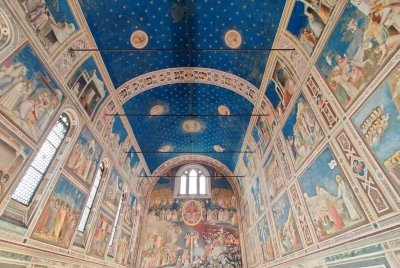
I was really dazzled by the frescoes of Padua. And I went on a Monday. Don't go on a Monday if you can avoid it -- several attractions are closed. But it was the only day that fit into our schedule. Still, we got to go in the Scrovegni Chapel, Saint Anthony, and the Baptistry. Around town, we were able to enjoy the small market at the Prato, peek through the gates of the closed botanical garden, and eat lunch in the shadow of the Palazzo della Ragione. The highlight was certainly the magnificent Scrovegni. I really appreciated the introduction provided by the video you watch just prior to your turn entering the chapel itself. The Scrovegni frescoes are probably only surpassed by the Sistine Chapel and while at the Scrovegni, I liked to imagine Michaelangelo being inspired by this art. Of course the Baptistry was also very impressive -- the details of the biblical scenes coating its walls and ceiling were amazing and the audio commentary describes it all nicely.
We visited as a day trip by train from Verona, and this worked out very well. We even stopped off for a quick walk through Vicenza on the way back to Verona. We had bought our Urbs Picta pass online, and we made use of the fact that it included a tram pass to get across the city. All-in-all, it was a very delightful day and we were extremely pleased that we chose to visit. I wouldn't have …
Keep reading 0 commentsIlya Burlak
Padua’s fourteenth-century fresco cycles
Padua’s fourteenth-century fresco cycles (Inscribed)
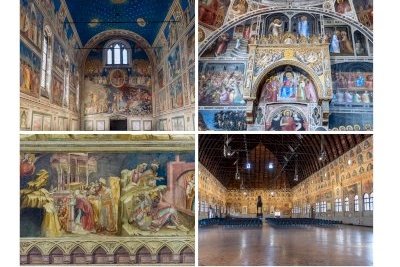
It is hard to say anything original about the magnificence of these frescoes. This serial site is definitely one of the most impressive of its kind. Visiting all of its components is possible on a single Urbs Picta ticket, which is what I did in June of 2022.
Scrovegni Chapel is the headline item and one place that requires advance planning. You have to book a specific 15-minute time slot to visit when you buy your ticket online (you actually end up with a voucher to be exchanged for the actual ticket at the Musei degli Eremitani). The printed ticket somewhat amusingly declares that unless you are at the entrance at least 5 minutes before your scheduled time, you will not be let in. I was there a good 15 minutes before but told the lady at the door that I would sit outside of the glass entry pavilion instead of being inside. It turned out that I had to sit through the introductory movie prior to getting into the chapel. Once a group that was inside the chapel was exiting and the group inside the pavilion was proceeding to the chapel, the next group would be let into the pavilion to see the movie. I was allowed in with the next group and thus remain confused about whether the time slot on my ticket was for the pavilion entry or the actual chapel entry. In any case, the movie may be high on pathos but is actually not …
Keep reading 0 commentsGabLabCebu
Padua’s fourteenth-century fresco cycles
Padua’s fourteenth-century fresco cycles (Inscribed)
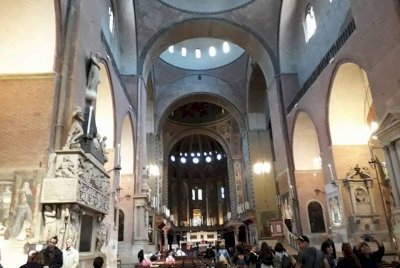
Unfortunately, I wasn't aware of the significance of the Scrovegni Chapel or the T-list site of Padua when I visited with my family back in April 2017. We visited the city for the sole purpose of seeing St. Anthony's grave, and I had just barely convinced my family to walk the few hundred meters to the Botanic Garden. Anyhow, the church was really interesting. I will guiltily admit that the paintings that the site is on the T-list for weren't the most memorable thing about the church, but it was interesting seeing the different architectural styles and artistic value, especially in the many side altars. Photography is not permitted, by the way, but apparently someone managed to sneak a nice picture of the whole church anyway. As with everyone else, I do believe in the undeniable OUV of the Scrovegni Chapel, which I hope to visit one day, but I also think that that Padua is a very beautiful and significant city that deserves World Heritage status other than just its lone monuments.
Keep reading 0 comments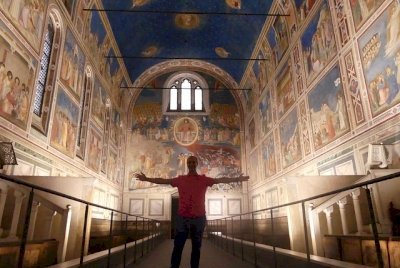
I had already visited Padua several times and I had visited the Scrovegni Chapel some 13 years ago but at the time photography wasn't allowed, so I didn't mind revisiting to take some photos of Padua's WHS and TWHS.
Moreover, I had seen an advert of the late opening hours of the Scrovegni Chapel plus the possibility of staying inside it double the amount of time which is usually allowed. It's no secret that even as a standalone site, the Scrovegni Chapel deserves inscription as a WHS. Conservation efforts have been more or less continuous over the past fifty years. To start with, the entire chapel had suffered from the nearby bombing during World War II. The facade was dangerously out of trim and had to be realigned. Next came the repairs to the old framework of the beamed ceiling, then the devising of a new system for draining off rainwater from the area beneath the chapel. After this came the decision to close off the adjacent Via Giotto to traffic, followed by the replacing of several tie-beams in the nave while the frescoes underwent highly specific inspection and maintenance.
During the 70s, the newly formed interdisciplinary Commission announced that atmospheric pollution constituted a major threat to the frescoes, so monitoring began, using the most up-to-date technology. Results clearly showed that improving the environment had to take priority over restoration. Meanwhile, steps were being taken to verify the static condition of the building, to protect it from seepage …
Keep reading 0 commentsEls Slots
Padua’s fourteenth-century fresco cycles
Padua’s fourteenth-century fresco cycles (Inscribed)
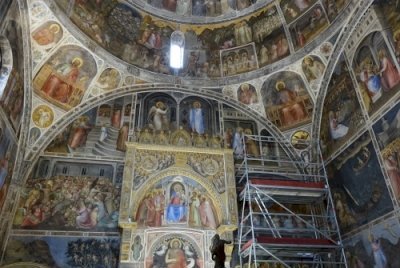
One of the disadvantages of almost having ‘finished’ Italy - I have 2 out of the 54 WHS left to visit - is that I am missing the regular weekend trips out there to enjoy the historic cities and their art. So although Padua’s Scrovegni Chapel is only up for nomination in 2020, last week I fitted in an easy weekend trip to this self-proclaimed ‘Capital of the 14th century fresco painting’. It even already has a nomination website and an epic title: Padova Urbs Picta (Latin for “painted city”).
I had been to Padua once before, in 2007. Then already I had a booking for the Scrovegni Chapel, but I ran out of time that day and only ‘did’ the WHS Orto Botanico. Now I had some 24 hours to spend in the city and I stayed overnight. Padua is not the most immediately likeable city: it has some prominent examples of fascist architecture, the railway station area is rather scruffy and it takes a long walk from there to get to the historic center – a center that is split into several piazza’s with not much of interest in between.
On my first afternoon I visited 4 out of the 9 proposed locations. I was staying near the Prato del Valle square, from where the Basilica del Santo is the closest location. This is a huge pilgrimage attraction – its interior holds the spectacular tomb of St. Anthony - but I did not manage to find …
Keep reading 0 commentsHubert
Padua’s fourteenth-century fresco cycles
Padua’s fourteenth-century fresco cycles (Inscribed)
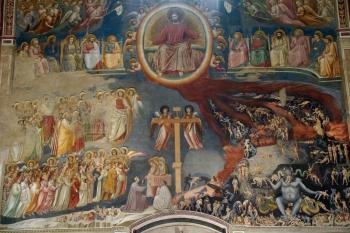
There is broad agreement among the reviewers on this website that the Scrovegni Chapel deserves a place on the World Heritage List and I can only emphasize once again the magnificence of these paintings. The Scrovegni Chapel was on the Italian tentative list as a single monument since the late 1990s, but it was never nominated. Recent activities suggest that things now get going: in January 2016, the T-list entry has been extended to include eight additional sites with frescoes from the 14th century, and it was reported that Padua is working on the nomination dossier and a management plan.
The Scrovegni Chapel is still the focus of the nomination: "It represents the most significant monument in the proposed series and the best-preserved fresco painting by Giotto” (cited from the T-list entry). Giotto di Bondone is the most famous artist of the Trecento (i.e. art and architecture of the 14th century in Italy) and an important forerunner of Renaissance. He introduced visual perspective in painting, his frescoes have spatial depth by the use of landscapes and architectural elements in the background, his characters are not static and flat, they show gestures and posture and individuality, Giotto "painted from life". The other sites of this serial nomination show frescoes by Giotto’s lesser-known successors. This website provides detailed information on the nine sites: locations, opening times, descriptions of the artworks and even audioguide tracks.
I visited the Scrovegni Chapel for the first time in 2004, and a weekend in Padua …
Keep reading 0 comments
The fact that this site is still on the tentative list is really a mortal sin! How can such a magnificent site be left out of the WHS list!!! This is truly Padova's highlight. It is a masterpiece - nothing more to add!
Keep reading 0 commentsAnonymous
Padua’s fourteenth-century fresco cycles
Padua’s fourteenth-century fresco cycles (Inscribed)

This site deserves to be added to the list. More than what the rest of Italy--Venice, Florence, Rome, the whole lot--can claim, it was this building that kick-started the European Renaissance and thus the modern world as we know it. It is also incredibly beautiful to boot. Along with the Orto Botanico, the Capella degli Ermani really shows that during its height Padova and its university was one of the most important centers of learning in the western world.
Keep reading 0 commentsIan Cade
Padua’s fourteenth-century fresco cycles
Padua’s fourteenth-century fresco cycles (Inscribed)
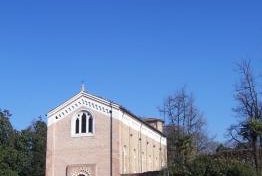
Magnificent!
This was the single highlight of my trip around the Veneto, and the finest site I have visited from the tentative list. It could easily make it onto the World Heritage list proper and I really hope it does.
The chapel is famous for its magnificent frescos painted by Giotto. There was something about the amazing misty colours of the interior that really grabbed my attention and held it. The 15 minutes or so we were in this small chapel enabled us to follow the story being depicted on the wall very closely, and gave plenty of time to really absorb the details of the art works, looking at the incredible emotion that Giotto was able to get into the depictions. This chapel is one of the key works of art from a major turning point in the western tradition; it shows the transition from gothic art to the more natural forms associated with the renaissance.
Entry to the chapel is restricted and you will have to book in advance (at least 3 days before but I would recommend booking as early as possible especially if you come in the high season). This limited entry means that a maximum of 25 people are allowed in the chapel at a time, which makes for an exceptionally rewarding way to see the paintings, allowing you time and space to really appreciate them (if only somewhere like the Sistine Chapel could give you the time and space to admire the artworks). Before …
Keep reading 0 comments
I went to Padua especially to see this marvelous Giotto capella and it was even more striking than I had expected. Giotto was indeed a genious. Padua by the way was heavily bombarded in WWII so many other sites including the nearby Capella degli Eremitani covered with frescoes by Mantegna were damaged. Nonetheless, the huge dining room (the largest in the world), Scuola San Giorgio, San Antonio complex, Prato della Valle, the Univeristy del Po' and the Battistero all offer the art lover great pleasures. Weren't it in Italy I'm sure a town like Padua would become a prominent tourist attraction and a country's main source of pride!
Keep reading 0 comments
